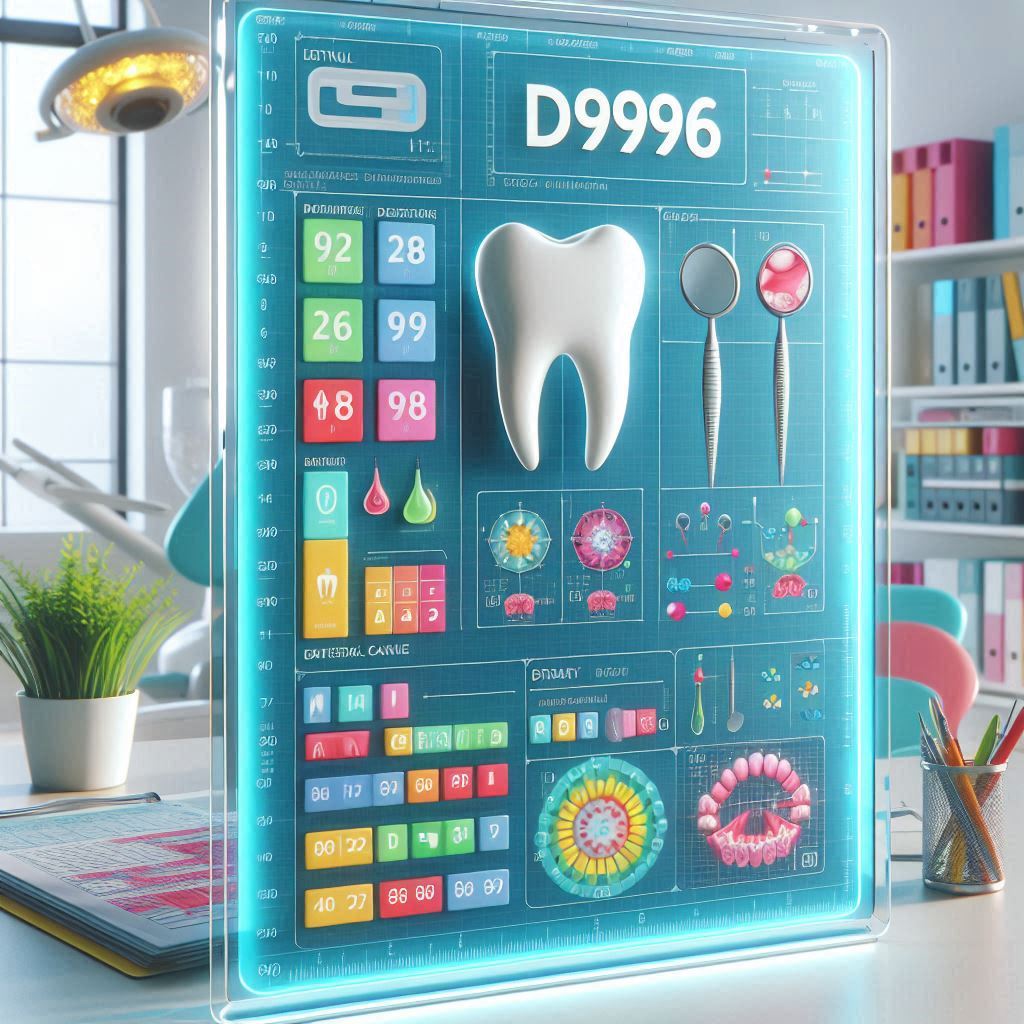D9996 Dental Code
Dental billing codes can be complex, but understanding them is crucial for both dental professionals and patients. One such code, D9996, plays a unique role in dental billing and insurance claims. Whether you’re a dentist looking to ensure accurate billing or a patient trying to decode your dental statement, this guide will provide an in-depth look at D9996, its applications, and its significance in modern dentistry.
This article will explore:
- The definition of D9996
- When and why it’s used
- How it differs from other dental codes
- Insurance implications
- Best practices for documentation
By the end, you’ll have a clear understanding of this essential dental billing component.

2. What is the D9996 Dental Code?
The D9996 code is a supplemental billing code used in dental practices. According to the American Dental Association (ADA), it falls under the category of “Adjunctive General Services” and is often used for teledentistry services.
Key Characteristics of D9996:
- Not a standalone procedure code – It is used in conjunction with other primary treatment codes.
- Supports remote dental consultations – Often linked with virtual visits or digital diagnostics.
- Enhances billing accuracy – Helps clarify additional services provided outside standard procedures.
3. Purpose and Importance of D9996
The D9996 code serves multiple purposes:
For Dentists:
✔ Ensures proper reimbursement for teledentistry services
✔ Helps document additional time spent on patient consultations
✔ Supports compliance with evolving dental billing standards
For Patients:
✔ Provides transparency in billing
✔ May reduce unnecessary in-office visits
✔ Facilitates access to remote dental care
For Insurance Providers:
✔ Standardizes claims for teledentistry
✔ Reduces disputes over supplemental services
✔ Encourages adoption of digital dental care
4. When is D9996 Used?
The D9996 code is typically applied in the following scenarios:
| Scenario | Application of D9996 |
|---|---|
| Teledentistry Consultations | Used for virtual follow-ups, pre-operative assessments, or post-operative check-ins. |
| Digital Imaging Reviews | Applied when dentists analyze X-rays or scans sent electronically. |
| Emergency Dental Advice | Covers remote evaluations for urgent dental concerns. |
| Patient Education | Used for virtual sessions explaining treatment plans or oral hygiene. |
5. Differences Between D9996 and Other Dental Codes
Many dental codes relate to specific procedures, but D9996 is unique because it supports non-face-to-face services.
Comparison Table: D9996 vs. Other Common Codes
| Code | Description | Key Difference |
|---|---|---|
| D9996 | Teledentistry / Supplemental Service | Used for remote consultations, not in-person treatments. |
| D0140 | Limited Oral Evaluation | In-person exam, not virtual. |
| D0210 | Full Mouth X-rays | Diagnostic imaging, not a consultation. |
| D9310 | Consultation with Medical Professional | In-person interdisciplinary discussion. |
6. Insurance Coverage and Reimbursement for D9996
Insurance policies vary, but many providers now recognize D9996 due to the rise of teledentistry.
Factors Affecting Reimbursement:
✅ Insurance Provider Policies – Some cover teledentistry, while others don’t.
✅ State Regulations – Certain states mandate teledentistry coverage.
✅ Documentation Requirements – Proper notes and records improve claim approval.
Tip: Patients should verify coverage with their insurer before a virtual visit.
7. Common Misconceptions About D9996
❌ Myth: “D9996 replaces in-person exams.”
✅ Fact: It supplements care but doesn’t eliminate the need for physical exams.
❌ Myth: “All insurers cover D9996.”
✅ Fact: Coverage varies—always check with the provider.
❌ Myth: “D9996 is only for emergencies.”
✅ Fact: It applies to routine follow-ups and consultations as well.
8. How Dentists Document and Report D9996
Proper documentation ensures smooth reimbursement:
- Record the Date & Duration of the virtual consultation.
- Specify the Reason (e.g., post-op check, emergency advice).
- Attach Supporting Files (e.g., digital images, patient messages).
- Link to Primary Procedure Code (if applicable).
9. Case Studies: Real-World Applications of D9996
Case Study 1: Post-Operative Follow-Up
A patient had a tooth extraction and used a D9996-coded virtual visit to confirm healing progress, avoiding an unnecessary office trip.
Case Study 2: Orthodontic Monitoring
An orthodontist used D9996 to review aligner progress via submitted photos, adjusting treatment remotely.
10. Future Trends in Dental Coding and D9996
With AI-driven diagnostics and expanded telehealth laws, D9996 will likely grow in importance. Future updates may include:
- Broader insurance acceptance
- Integration with AI dental assistants
- New sub-codes for specialized teledentistry services
11. Conclusion
The D9996 dental code is a vital tool for modern dentistry, enabling remote consultations and improving patient access to care. While insurance coverage varies, its role in teledentistry is expanding. Dentists should document D9996 accurately, and patients should verify benefits with insurers. As digital dentistry evolves, D9996 will remain a key component in efficient, patient-centered care.
12. Frequently Asked Questions (FAQs)
Q1: Does D9996 apply to phone consultations?
A: Typically, yes, if it involves professional dental advice.
Q2: Can I use D9996 for a first-time patient visit?
A: Usually no—initial exams often require in-person evaluation.
Q3: How much does a D9996 service cost?
A: Fees vary by practice, but it’s generally less expensive than an office visit.
Q4: Will Medicaid cover D9996?
A: Some state Medicaid programs do—check local guidelines.


